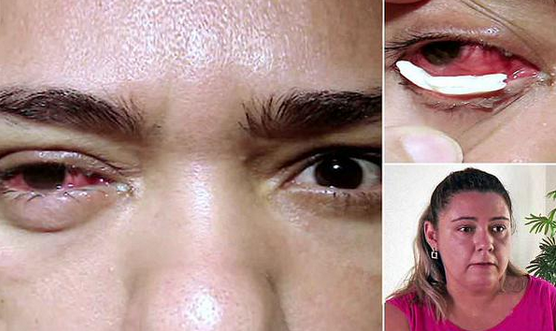Nursery School Teacher With Rare Eye Problem Cries Crystal Tears Due To Excessive Keratin Protein

A nursery school teacher in Brazil is finally able to go back to work after taking off months at a time to treat a mysterious condition — crystallized tears. Laura Ponce, 35, of Lins, has been plagued with a rare eye problem that causes her to secrete a clot of white plaque that morphs into a solid crystal after blinking and reaching the air near the eye’s surface. After 20 years and numerous doctors’ visits, Ponce found a specialist who could explain her strange affliction.
Dr. Raul Goncalves, an ophthalmologist at Hospital de Olhos de Bauru, conducted a series of tests on a jar of Ponce’s crystallized tears, the DailyMail reported. He came to the conclusion her white crystals are the result of her eyes producing excessive amounts of keratin protein. This eye protein is believed to have germ-killing power that can ward off nasty pathogens.
Goncalves told Barcroft TV: “For these plaques to form so fast there could only be one explanation: It must be chemical. Every time we blink you’re lubricating your eye, and tears are made of three layers — a water layer, a mucin layer, and a fat layer. Each cell separately creates a product, and when you blink you mix all this like a dough.”
Typically, when bacteria attacks the eye, the protein contents of the tear defend it, but for Ponce, this line of defense doesn’t work. Therefore, her eyes are forced to use the second line of defense — the cornea. The cornea, which secretes keratin, jumps into action. Keratin and other components are what lead to the crystallization of tears.
Woman cries mysterious white crystals http://t.co/8onN1Wdq0n pic.twitter.com/DnE2l3FTa8
— Daily Mail Online (@MailOnline) August 5, 2015The production of these white clots have led the woman's eye to swell on multiple occasions. Habitually, Ponce opens her eyes wide to take out the relatively thick and wide membrane to avoid discomfort. She and her mom Marisa recalled the first time they discovered the white crystals at age 15: “We checked inside and there was a thick membrane. We took it out and I was scared. We ran to the ER and the doctor on duty also got scared. The doctor was mystified.”
Ponce’s condition got relatively worse two years ago when her eye was infected for six months. “I’m a nursery school teacher, I get angry not being able to work,” she said. Unfortunately, she spent those six months removing up to 30 hard white plaques a day, which would form into a membrane on her eye.
Now, with the help of Goncalves, she is able to better manage her condition through prescribed silver nitrate drops. This helps to reduce eye infections so she can finally go back to work. “My expectations are for my eyes to be cured and for everything to be fine.”
Ponce’s case is so unique doctors are yet to find a case similar to hers in medical literature.



























